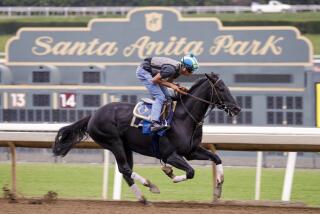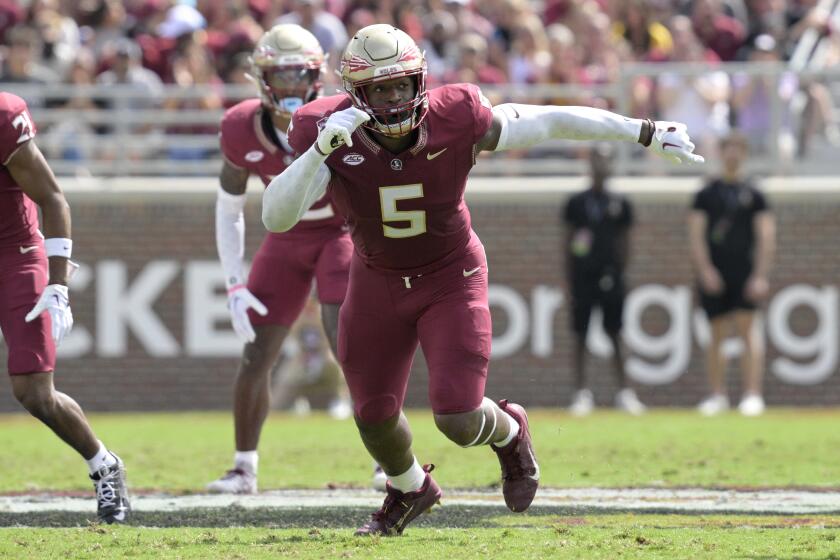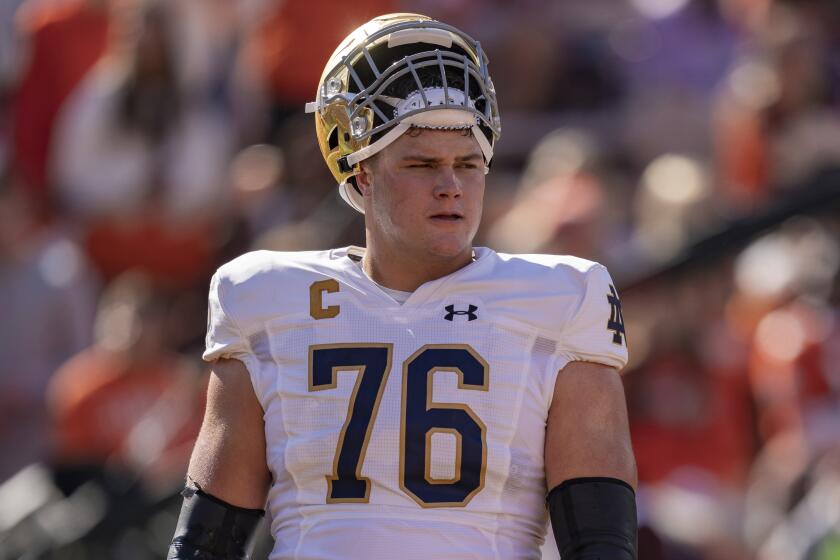Songbird romps to eighth consecutive victory
The talk at a toasty Santa Anita on Saturday was two things. How hot and how good?
The first one, the temperature, you can measure, 97 degrees. The second one, how good is Songbird, is a question that has yet to be answered.
The 3-year-old filly won for the eighth time in eight tries, vanquishing a field of five in $200,000 Summertime Oaks by 6½ lengths. It brings her cumulative margin of victory to a can-you-believe-it 42½ lengths.
In fact, jockey Mike Smith just galloped her in from just past the 3/8th pole to the finish line.
“It’s freaky,” Smith said. “If there was someone in front of her to make her focus and make her run, there’s no telling how fast she’ll run.”
The race set up a little differently, as Martin Garcia took Bellamentary to the front with Songbird sitting off her shoulder. Usually Songbird goes to the lead and stays there. It wasn’t until past the half-mile of the 1 1/16th-mile race that Songbird decided she was in second place long enough. Once she grabbed the lead there was no doubt she would remain unbeaten.
The prices were consistent with Songbird, who brought the fourth minus show pool bet on her this year. There was $1,017,594 wagered that the horse would finish in the top three. Songbird paid $2.10 to win, $2.10 to place and $2.10 to show, the minimum payoffs allowed. Bellamentary paid $2.40 and 2.10 and Kay Kay was $2.10 to show. The $1 exacta paid an unheard-of $2.
The goal early in the year was to have her ready for the Kentucky Oaks, but she developed a fever after winning the Santa Anita Oaks on April 9 and took some time off. This was her comeback race.
It’s unclear where she will run next, but it probably will be back east against fillies.
“Probably she won’t have anything to run at Del Mar,” said trainer Jerry Hollendorfer, who celebrated his 70th birthday Saturday. “We’ll probably train her down there and ship back east for any number of races that we’ve talked about.”
Fans want to see the filly go against the boys, but that doesn’t seem likely.
“Mr. Porter likes having input on these things, so we’ll make a plan,” Hollendorfer said of owner Rick Porter. “I think we’ll stick with the girls for now and see what happens.”
Hollendorfer admits he was glad the race was Saturday, rather than Sunday.
“It’s going to be hotter tomorrow, so all the guys have been talking about that,” Hollendorfer said. “We take enough out of our horses as it is, so the heat worries us a little bit. But today it didn’t look like she got hot at all.”
Santa Anita moved up its Sunday post time from 1:30 to noon in order to avoid the heat, which is expected to reach or surpass triple digits. But, like the old joke goes, it’s not the heat but the humidity.
Rick Arthur, equine director at both the UC Davis School of Veterinary Medicine and California Horse Racing Board, says California is mostly immune from the heat and humidity dangers of the East Coast or Midwest.
“The humidity is really the most important factor in a horse’s ability to dissipate heat,” Arthur said. “The heat index at Santa Anita on these high, hot summers is not a problem. Now you do see problems when the weather turns quickly. But there are more problems in February when the temperature goes from 65 to 85 than when it goes from 85 to 95 or 100 in the summer.”
The heat index is a combination of heat and humidity. Meteorologists like to use the phrase “feels like (temperature)” as a way to explain it.
On Sunday, at noon, according to weather.com, the temperature is expected to be 96 with 11% humidity. That equals a heat index of 91. The index does climb: (99 temperature/11% humidity) 94 at 1 p.m., (100/13) 95 at 2 p.m., (101/13) 96 at both 3 p.m. and (100/13) 95 at 4 p.m. Experts say you shouldn’t race if the index is near 105.
Arthur has a simpler way of computing the danger, just add the temperature and humidity and you shouldn’t worry until it gets around 160 to 165.
“Even when the temperature is 90 to 100 at Santa Anita, the heat index is higher at Del Mar when it’s in the 80s,” Arthur said. “That has to do with the humidity.”
Track vets and trainers are attuned at what to look for when horses are being affected by the heat. They become more anxious, they start to back up, throw their head back and start pawing the ground.
“Unlike dogs, horses are like humans and they lose heat by sweating,” Arthur said. “If you put water on them it takes the heat off. That’s why horses are sponged sometimes before or in the paddock and certainly after the races.”
So in what likely will be Songbird’s last Southern California appearance this year until the Breeders’ Cup at Santa Anita, she revived the debate that she’s not only the best 3-year-old filly but the best 3-year-old, period.
john.cherwa@latimes.com
More to Read
Get our high school sports newsletter
Prep Rally is devoted to the SoCal high school sports experience, bringing you scores, stories and a behind-the-scenes look at what makes prep sports so popular.
You may occasionally receive promotional content from the Los Angeles Times.







